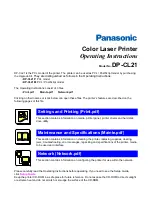
4
4-9
Pi5500 on a NetWare 3.x, 4.x, or 5.x network
Setting up an NDS connection
In NDS, all NetWare entities (objects) are organized in a hierarchical tree structure.
Objects have a name, properties, and a context that defines the location of the object in
the directory tree. For the Pi5500 you are mainly concerned with defining a printer, a
print server object and one or more print queue objects. Objects are created in
NetWare administrator programs such as PCONSOLE, NETADMIN, or NetWare
Administrator.
The top-level tree object is known as the [Root] object. The name of the [Root] object
is also the name of the tree. Below the [Root] are other objects: either containers
(which consist of other objects) or leaf objects (which do not contain other objects).
Access to objects is controlled by rights that are defined as properties of each object.
Rights are established by network administrators.
Setting the NetWare 4.x bindery context
You can connect only one directory tree to the Pi5500. If you need to connect
additional NetWare 4.x servers, you can do so by using bindery emulation, which
causes the 4.x server to behave like and be accepted as a NetWare 3.x server.
N
OTE
:
The file server selected must not be in the same tree as that selected in
NDS Setup.
Up to eight bindery servers, whether in native 3.x mode or in 4.x emulation, can
connect to the Pi5500. If your server is using NetWare 3.x, proceed to “Setting up a
Pi5500 print queue for bindery” on page 4-10.
In order to set up the NetWare 4.x server in bindery emulation mode for printing to
the Pi5500, the network administrator must do the following:
• Determine the Directory Services path to the container in which the print server and
the print queue for the Pi5500 will be created.
The container defines the “bindery context” for your network structure.
• Edit the network startup file to set the bindery context.
• Activate the new bindery context.
















































